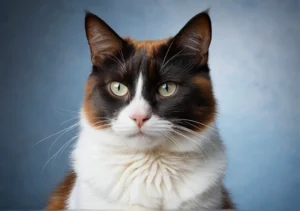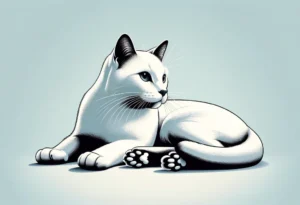Have you noticed your black cat sporting a few unexpected white hairs? It’s a curious sight that leaves many cat owners scratching their heads.
Your black cat may have white hairs due to a mix of genetics, aging, or even environmental factors. These white hairs can indicate various harmless conditions, including a natural variation in fur pigmentation. But there’s a lot more to uncover about the fascinating reasons behind those unexpected flecks, so stick around to find out!

The Role of Genetics
Genetics is a major player in determining the coat color of black cats and can help explain the presence of white hairs. Much like humans, cats inherit their physical traits from their parents, including fur pigmentation. In many cases, genetic mutations can create variations in color. For instance, the graying gene—also known as the dilute gene—might cause a black cat to develop a sprinkling of white or gray hairs over time.
Some breeds are more prone to this than others. For example, Oriental breeds, which can have a diverse range of colors, often feature the potential for those surprising white hairs. Furthermore, environmental factors may also interact with genetic predispositions, affecting pigmentation. For instance, sun exposure can lighten a cat’s fur, allowing underlying colors to peek through.
In summary, the mixture of your cat’s genetics, breed traits, and environmental influences can culminate in those curious white hairs that keep you guessing.
Aging and Maturation
As your black cat ages, you might notice some white hairs making their debut—a natural part of life for many felines. Just like in humans, the aging process gradually affects fur color. Over the years, melanin—the pigment responsible for color—can decrease in production. This means those once-deep black tufts may start to give way to strands of white, showcasing your beloved companion’s maturity.
It’s also worth noting that stress, health changes, and hormonal fluctuations during your cat’s life can influence the rate at which they develop white hairs. For instance, older cats may experience changes in grooming habits due to arthritis or dental issues, leading to uneven wear on the coat and the appearance of white hairs in specific areas.
To ensure your aging cat stays healthy, keep an eye on their diet and regular vet check-ups, as a well-rounded approach can help manage these changes more smoothly. Plus, those white hairs can be a badge of honor, telling the story of a life well-lived.
Environmental Factors
A black cat sporting white hairs can be a puzzle, but it often comes down to environmental influences. One primary factor is sun exposure. Prolonged sunlight can lighten fur, leading to those unexpected white strands. If your kitty lounges in sunny spots, it’s absorbing UV rays that can fade its black coat over time.
Another consideration is stress. Cats, like us, can react to anxiety in various ways. Some may develop a phenomenon known as canities, where stress triggers the premature graying of fur. This can manifest as white or gray hairs popping up in an otherwise solid coat. Pay attention to environmental changes, like new pets or moving homes, which might cause your cat to feel uneasy. Keeping a calm environment can help reduce stress and its effects on fur.
Nutrition and Diet
A balanced diet is crucial for your cat’s overall health, including its coat. Insufficient nutrition can lead to coat discoloration or fading. If your black cat has white hairs, it might be worthwhile to revisit its food.
Focus on specific nutrients known for enhancing fur health, like:
- Omega-3 Fatty Acids: These promote a shiny coat and hydrate the skin.
- Biotin: This vitamin aids in maintaining fur’s richness and color.
- Amino Acids, especially tyrosine, which is vital for melanin production; reducing its levels can lighten a cat’s coat.
Also, consider the quality of the cat food. Premium brands often provide better nutrition suited for maintaining a luscious black coat. Regular vet check-ups can help ensure your cat is getting the nutrients it needs.
Health Conditions
While the appearance of white hairs on your black cat may come as a surprise, it could signal underlying health conditions worth investigating. One possibility is vitiligo, a skin condition that can lead to a loss of pigment. This usually results in white patches on the skin and fur.
Another concern is allergies, which can cause itching or irritation. If your cat is over-grooming due to these sensitivities, it might lead to white hair changes as well. Conditions like hormonal imbalances or chronic skin infections can also play a role in altering coat color. If you notice sudden or extensive changes in your cat’s fur, consulting your veterinarian is a wise move. They can help identify any medical issues and recommend appropriate treatments or changes in care based on your cat’s specific needs.
Non-Genetic White Hairs
Your black cat’s white hairs might not be anything to worry about; they could simply reflect some temporary factors in their environment or grooming routine. Sun exposure can lighten fur over time, especially in areas where light hits directly. Additionally, if you’re using grooming products containing bleach-like substances, your cat’s coat could absorb these chemicals, leading to white spots.
Sometimes, stress can also play a part. If your feline friend is anxious, it might over-groom, resulting in different fur textures and colors. Another factor is the natural aging process. As cats age, it’s normal for them to develop a mix of colors in their fur, which could mean a sprinkle of white hairs even on the most jet-black coat. Keeping tabs on changes and ensuring your cat has a stress-free environment can help maintain their beautiful coat.
Trivia and Fun Facts
Black cats are often shrouded in mystery, adding to their allure. One intriguing reason your black cat might sport white hairs is due to a phenomenon called “grizzling.” This natural process occurs as cats age, where some black fur loses pigment and turns gray or white. Surprisingly, even younger black cats can have this, often resulting from genetics or environmental factors.
Another interesting tidbit: certain breeds, like the Bombay or American Shorthair, are more prone to these color variations. Scientists also discovered that specific genetic markers influence coat color patterns, leading to those charming white flecks. So, when you spot those little white hairs, it might just be your cat’s unique style shining through!
Cultural Beliefs and Myths
Throughout history, black cats have captured our collective imagination, often linked to superstition and folklore. Many cultures view them with mixed feelings, assigning various meanings to their distinct appearance. For instance, in ancient Egypt, black cats were revered for their grace and considered symbols of good luck—often associated with the goddess Bastet.
On the flip side, in parts of Europe, they were seen as omens of bad fortune, with their unusual fur color fueling fears of witchcraft. These perspectives often impacted the adoption and care of black cats, leading to both adoration and discrimination.
Interestingly, the white hairs mixed in with their coat contribute to their mythic status. Some believe these white hairs signify a spiritual presence, symbolizing protection, while others dismiss them as signs of supernatural activity. Such interpretations continue to weave a rich tapestry of lore around these beautiful creatures, capturing hearts and imaginations across cultures.
Alex, a passionate animal lover, has experience in training and understanding animal behavior. As a proud pet parent to two dogs and three cats, he founded AnimalReport.net to share insights from animal experts and expand his knowledge of the animal kingdom.




